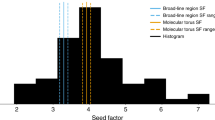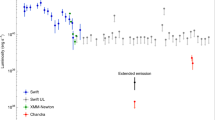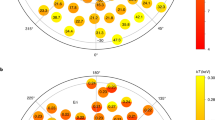Abstract
An unresolved X-ray glow (at energies above a few kiloelectronvolts) was discovered about 25 years ago and found to be coincident with the Galactic disk—the Galactic ridge X-ray emission1,2. This emission3,4,5,6,7,8,9,10 has a spectrum characteristic of a ∼108 K optically thin thermal plasma, with a prominent iron emission line at 6.7 keV. The gravitational well of the Galactic disk, however, is far too shallow to confine such a hot interstellar medium; instead, it would flow away at a velocity of a few thousand kilometres per second, exceeding the speed of sound in the gas. To replenish the energy losses requires a source of 1043 erg s-1, exceeding by orders of magnitude all plausible energy sources in the Milky Way11. An alternative is that the hot plasma is bound to a multitude of faint sources12, which is supported by the recently observed similarities in the X-ray and near-infrared surface brightness distributions13,14 (the latter traces the Galactic stellar distribution). Here we report that at energies of ∼6–7 keV, more than 80 per cent of the seemingly diffuse X-ray emission is resolved into discrete sources, probably accreting white dwarfs and coronally active stars.
This is a preview of subscription content, access via your institution
Access options
Subscribe to this journal
Receive 51 print issues and online access
$199.00 per year
only $3.90 per issue
Buy this article
- Purchase on Springer Link
- Instant access to full article PDF
Prices may be subject to local taxes which are calculated during checkout



Similar content being viewed by others
References
Worrall, D. M. et al. HEAO 1 measurements of the Galactic ridge. Astrophys. J. 255, 111–121 (1982)
Warwick, R. S. et al. The Galactic ridge observed by EXOSAT. Nature 317, 218–221 (1985)
Koyama, K. et al. Thermal X-ray emission with intense 6.7-keV iron line from the Galactic ridge. Publ. Astron. Soc. Jpn 38, 121–131 (1986)
Yamauchi, S. & Koyama, K. The 6.7 keV iron line distribution in the Galaxy. Astrophys. J. 404, 620–624 (1993)
Yamauchi, S. et al. Unresolved X-ray emission from the Galactic ridge with ASCA. Publ. Astron. Soc. Jpn 48, L15–L20 (1996)
Hands, A. D. P. et al. X-ray source populations in the Galactic plane. Mon. Not. R. Astron. Soc. 351, 31–56 (2004)
Ebisawa, K. et al. Chandra deep X-ray observation of a typical Galactic plane region and near-infrared identification. Astrophys. J. 635, 214–242 (2005)
Koyama, K. et al. Iron and nickel line diagnostics for the Galactic Center diffuse emission. Publ. Astron. Soc. Jpn 59, 245–255 (2007)
Ebisawa, K. et al. Spectral study of the Galactic ridge X-ray emission with Suzaku. Publ. Astron. Soc. Jpn 60, 223–230 (2008)
Yamauchi, S. et al. Iron emission lines on the Galactic ridge observed with Suzaku. Preprint at <http://arxiv.org/abs/0810.0317> (2008)
Tanaka, Y. ASCA observation of X-ray emission from the Galactic ridge. Astron. Astrophys. 382, 1052–1060 (2002)
Worrall, D. M. & Marshall, F. E. Stellar contributions to the hard X-ray Galactic ridge. Astrophys. J. 267, 691–697 (1983)
Revnivtsev, M. et al. Origin of the Galactic ridge X-ray emission. Astron. Astrophys. 452, 169–178 (2006)
Revnivtsev, M., Molkov, S. & Sazonov, S. Map of the Galaxy in the 6.7-keV emission line. Mon. Not. R. Astron. Soc. 373, L11–L15 (2006)
Park, S. et al. Characteristics of diffuse X-ray line emission within 20 parsecs of the Galactic Center. Astrophys. J. 603, 548–559 (2004)
Sazonov, S. et al. X-ray luminosity function of faint point sources in the Milky Way. Astron. Astrophys. 450, 117–128 (2006)
Weisskopf, M. C. et al. An overview of the performance and scientific results from the Chandra X-Ray Observatory. Publ. Astron. Soc. Jpn 114, 1–24 (2002)
Giacconi, R. et al. Evidence for X-rays from sources outside the Solar System. Phys. Rev. Lett. 9, 439–443 (1962)
Hickox, R. C. & Markevitch, M. Absolute measurement of the unresolved cosmic X-ray background in the 0.5–8 keV band with Chandra. Astrophys. J. 645, 95–114 (2006)
Moretti, A. et al. The resolved fraction of the cosmic X-ray background. Astrophys. J. 588, 696–703 (2003)
Dutra, C. M. et al. Extinction within 10° of the Galactic Centre using 2MASS. Mon. Not. R. Astron. Soc. 338, 253–262 (2003)
Indebetouw, R. et al. The wavelength dependence of interstellar extinction from 1.25 to 8.0 μm using GLIMPSE data. Astrophys. J. 619, 931–938 (2005)
Sunyaev, R. A., Markevitch, M. & Pavlinsky, M. The center of the Galaxy in the recent past—a view from GRANAT. Astrophys. J. 407, 606–610 (1993)
Koyama, K. et al. ASCA view of our Galactic Center: remains of past activities in X-rays? Publ. Astron. Soc. Jpn 48, 249–255 (1996)
Vikhlinin, A. et al. Chandra temperature profiles for a sample of nearby relaxed galaxy clusters. Astrophys. J. 628, 655–672 (2005)
Chandra. Proposers’ Observatory Guide <http://cxc.harvard.edu/proposer/POG/html/index.html> (23 January 2009)
Hellier, C., Mukai, K. & Osborne, J. P. Iron Kα linewidths in magnetic cataclysmic variables. Mon. Not. R. Astron. Soc. 297, 526–530 (1998)
Huenemoerder, D., Canizares, C. & Schulz, N. X-ray spectroscopy of II Pegasi: coronal temperature structure, abundances, and variability. Astrophys. J. 559, 1135–1146 (2001)
Acknowledgements
M.R. thanks M. Markevitch for his help with the Chandra instrumental background. This research was supported by the DFG Cluster of Excellence “Origin and Structure of the Universe”, by NASA Chandra grant GO8-9132A, by the OFH-17 programme of the Russian Academy of Sciences, and by grants RFFI 07-02-01004 and RFFI 07-02-00961.
Author information
Authors and Affiliations
Corresponding author
Rights and permissions
About this article
Cite this article
Revnivtsev, M., Sazonov, S., Churazov, E. et al. Discrete sources as the origin of the Galactic X-ray ridge emission. Nature 458, 1142–1144 (2009). https://doi.org/10.1038/nature07946
Received:
Accepted:
Issue Date:
DOI: https://doi.org/10.1038/nature07946
This article is cited by
-
Measuring the cosmic X-ray background accurately
Experimental Astronomy (2023)
-
X-ray polarization evidence for a 200-year-old flare of Sgr A*
Nature (2023)
-
MVN experiment – All sky monitor for measuring cosmic X-ray background of the universe onboard the ISS
Experimental Astronomy (2021)
-
A polarized view of the hot and violent universe
Experimental Astronomy (2021)
-
Extended hard-X-ray emission in the inner few parsecs of the Galaxy
Nature (2015)
Comments
By submitting a comment you agree to abide by our Terms and Community Guidelines. If you find something abusive or that does not comply with our terms or guidelines please flag it as inappropriate.



